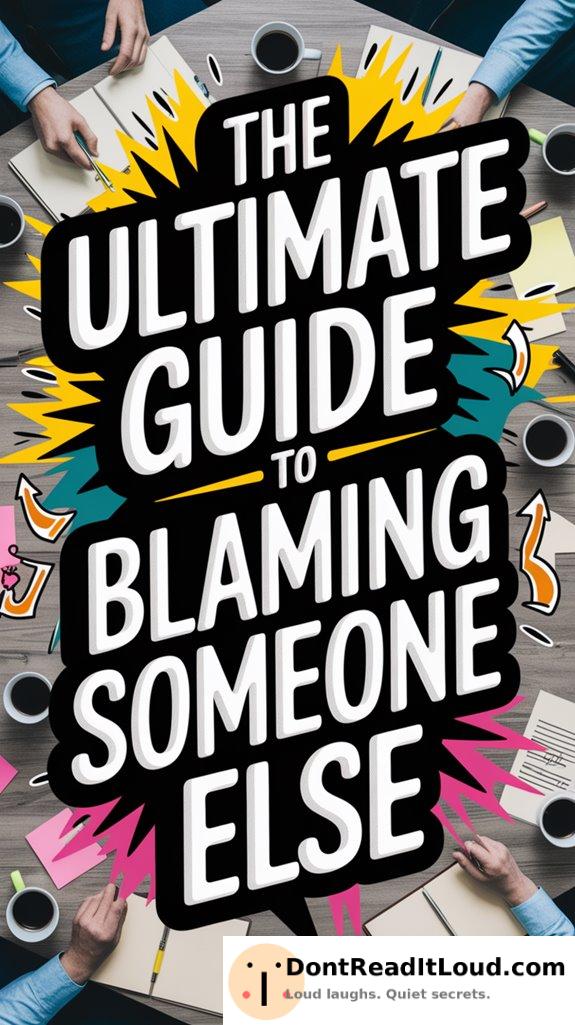
If you want to master blaming someone else, start by understanding your own motives and emotional triggers. Use tactics like redirecting attention to another person’s mistake, being deliberately vague, or mentioning complicated circumstances to obscure responsibility. Remember, avoiding accountability can damage your reputation and erode others’ trust. Notice how blame often moves through groups—it’s rarely just one person at fault. As you refine these techniques, you’ll see how blame truly operates behind the scenes.
Understanding the Psychology of Blame

Blaming others might feel instinctive, but it’s a nuanced reaction shaped by your background, environment, and emotions.
When you feel uneasy or threatened, your mind uses defense mechanisms to protect your self-image. Assigning blame can shield you from the discomfort of criticism or personal failure.
Sometimes, you may project your own guilt onto others to avoid facing it yourself. This helps you sidestep difficult self-reflection.
Over time, these patterns can become automatic, making it hard to see your own contribution to problems.
Recognizing why you blame others is the first step toward healthier coping strategies.
Classic Techniques for Shifting Responsibility

When you want to avoid taking the fall, you might rely on well-worn tactics that shift responsibility onto others. One classic technique is to highlight someone else’s mistake, subtly steering attention away from your own role.
You can also use vague language or passive voice—say, “Mistakes were made”—to create distance between yourself and the problem. If questions arise, it helps to redirect criticism by pointing to a colleague or blaming external factors.
Another approach is to emphasize how busy you’re or stress the situation’s complexity, suggesting anyone could have made the same error. By consistently dodging accountability, you encourage others to accept your reasoning without further scrutiny.
Mastering these techniques helps you avoid blame, protect your reputation, and ease your mind.
Common Pitfalls When Passing the Buck

While shifting blame can seem like a quick fix, it’s easy to miss the risks involved. When you dodge accountability, people may see you as unreliable.
If you regularly point fingers, others begin to question your integrity. You might also miss valuable chances to learn and improve, since owning mistakes helps you grow.
Your relationships at work can also take a hit; trust fades when colleagues sense you aren’t honest about errors.
Passing the buck can backfire, too—if the truth comes out, the fallout might be worse than if you’d admitted fault early on.
Choose your actions carefully.
Social Dynamics of the Blame Game

If you’ve ever watched a team scramble after a mistake, you know how quickly blame can ripple through a group. The social dynamics at play are powerful.
When you assign blame, you’re not just shifting responsibility—you’re shaping how others interpret the situation. Social influence determines who faces criticism and who’s excused.
People often look to leaders for guidance, but peer pressure also affects judgment. If you blame someone first, others may follow your example.
Alliances can emerge, and loyalties may shift as everyone tries to avoid fault. Understanding these dynamics helps you handle the blame game and anticipate others’ reactions.
Turning Blame Into a Team Sport

Although it’s tempting to single out one person after a mistake, teams often share blame to protect themselves.
In a group, responsibility can easily be deflected by everyone. Team collaboration shifts—not just for the work, but also for deciding who’s responsible. This behavior creates a culture where finger-pointing is common and true accountability gets lost.
Instead of facing problems directly, team members may work together to hide the real cause. While this may feel safer at first, it damages trust and weakens real teamwork.
In the end, turning blame into a group activity hinders growth and genuine collaboration.
Conclusion
Now you understand the details of shifting blame—why it happens, how to do it, and what to look out for. Remember, blaming others may offer short-term relief, but it can harm trust and relationships over time. If you feel the need to assign blame, do so thoughtfully and with caution. Even better, choose to take responsibility and learn from your mistakes. That’s the path to real leadership.



